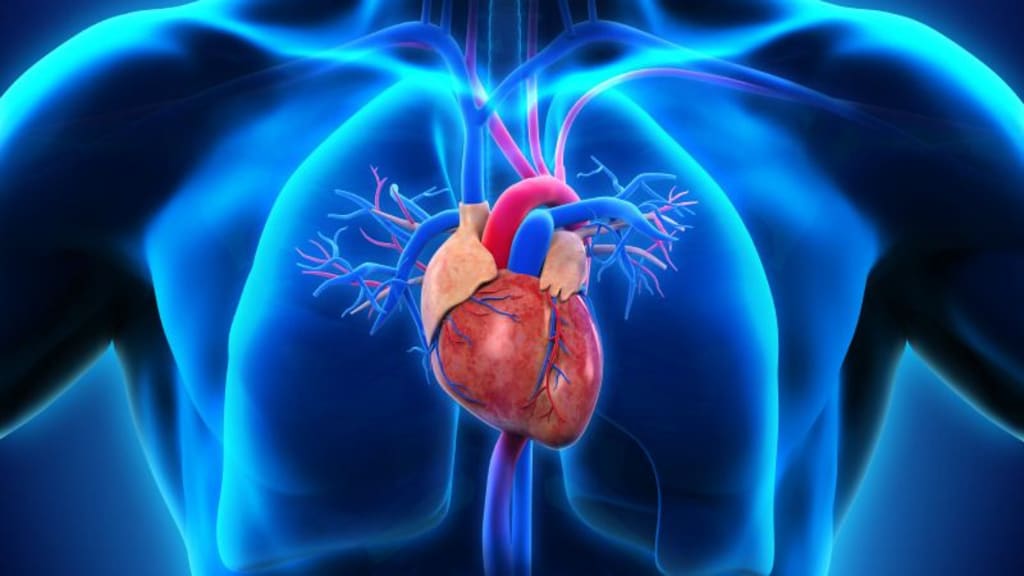Content warning
This story may contain sensitive material or discuss topics that some readers may find distressing. Reader discretion is advised. The views and opinions expressed in this story are those of the author and do not necessarily reflect the official policy or position of Vocal.
HEART: ANATOMY AND FUNCTION
EVERYTHING YOU NEED TO KNOW ABOUT HEART

Overview
The heart is a vital organ in the human body due to its central role in blood circulation. It serves as the powerhouse of the circulatory system; the heart tirelessly pumps blood, ensuring the transportation of vital oxygen, nutrients, and hormones to various tissues and organs. This continuous circulation is crucial for cellular function, providing the life-sustaining elements necessary for metabolic processes. Heart anatomy, comprising four chambers and a network of valves and vessels, allows for the seamless coordination required for efficient blood circulation. If the individual heart is healthy, it is linked to overall well-being. Let’s unfold detailed information about the heart and its anatomy.
Anatomy of Heart
The human heart is a roughly fist-sized, cone-shaped organ in the thoracic cavity between the lungs, behind the sternum, and slightly to the left. It is enclosed within a double-walled sac called the pericardium, which provides protection and lubrication for the heart.
The heart is divided into four chambers: two atria (upper chambers) and two ventricles (lower chambers).
Right Atrium. The right atrium receives deoxygenated blood from the body through the superior and inferior vena cava. From the right atrium, blood flows into the right ventricle, which pumps it to the lungs for oxygenation.
Left Atrium. The left atrium receives oxygenated blood from the lungs via the pulmonary veins, which are pumped into the left ventricle. The most robust chamber, the left ventricle, propels oxygenated blood throughout the body.
Left Ventricle. Pumps oxygen-rich blood to the body’s organs and tissues, providing essential nutrients and oxygen for cellular functions.
Right Ventricle. Sends oxygen-depleted blood to the lungs for oxygenation, allowing the removal of carbon dioxide and replenishing the oxygen supply.
Anatomy of the heartAnatomy of the heart
The heart’s wall is differentiated into three layers:
Epicardium: It is the outermost, thinnest, and most protective layer. It contains blood vessels and connective tissue.
Myocardium: It is the middle, thick layer made of muscular tissue. It is rich in blood vessels and responsible for the pumping action.
Endocardium: It is an innermost, smooth, and thin layer. It facilitates smooth blood flow.
Structure of the heart wallStructure of the heart wall
Function of Heart
The coordinated actions of the heart chambers, valves, and blood vessels contribute to maintaining circulation. The primary functions of the heart can be outlined as follows:
Pumping blood: The heart’s primary function is to pump blood throughout the body, ensuring a continuous flow of oxygen and nutrients to all cells.
Circulation: The heart facilitates blood circulation through two main pathways: pulmonary circulation, where blood is oxygenated in the lungs, and systemic circulation, which delivers oxygen-rich blood to the body’s tissues.
Oxygen transport: By pumping oxygenated blood, the heart provides vital oxygen to cells and removes carbon dioxide, a waste product of cellular metabolism.
Nutrient delivery: The heart is crucial in transporting nutrients, such as glucose and electrolytes, to various tissues and organs, sustaining their proper functioning.
Waste removal: In collaboration with the circulatory system, the heart helps eliminate metabolic waste products from cells, aiding in the body’s overall detoxification.
Maintaining blood pressure: The heart regulates blood pressure by adjusting its pump’s force, ensuring stable and efficient circulation.
Electrical conduction: The heart generates electrical impulses that coordinate the contraction and relaxation of its chambers, maintaining a synchronised pumping action.
Vital organ support: Ultimately, the heart’s function is indispensable to the survival and well-being of all other organs and systems in the body, making it a central player in maintaining homeostasis.
When to Consult a Doctor
You can also get in touch with the expert cardiology doctors at Narayana Healthcare based in your city to get immediate attention and medical support during injuries, health disorders or any other health concern.
Best Cardiologists in delhi
Best Cardiologists in bangalore
Best Cardiologists in ahmedabad
Best Cardiologists in gurugram
Best Cardiologists in Kolkata
Best Cardiologists in jaipur
Conclusion
The heart is a remarkable organ with a complex anatomy and vital functions. Its ability to efficiently pump blood and adapt to the body’s requirements is essential for sustaining life. Knowing its anatomy and function is crucial for appreciating the significance of cardiovascular health and preventing heart-related disorders. Regular exercise, a balanced diet, and a healthy lifestyle contribute to maintaining optimal heart function, ensuring a longer and healthier life.
FAQs About Heart
Q. What is the anatomy of the heart?
A. The heart has four chambers: two atria (upper chambers) and two ventricles (lower chambers). It is divided into the left and right sides, each responsible for pumping blood to different body parts.
Q. What are the three layers of the heart?
A. The heart comprises three layers: the outer epicardium, the middle myocardium responsible for contractions, and the inner endocardium lining the chambers. Together, these layers ensure the heart’s structural integrity and optimal functioning.
Q. How does blood flow through the heart?
A. Deoxygenated blood returns to the right atrium, is pumped into the right ventricle and is then sent to the lungs for oxygenation. Oxygenated blood returns to the left atrium, is pumped into the left ventricle and then circulates to the rest of the body.
Q. What are the seven main functions of the heart?
A. The heart performs seven essential functions: pumping oxygenated blood to body tissues, receiving deoxygenated blood, maintaining blood pressure, routing blood through the lungs for oxygenation, regulating blood flow by adjusting heart rate, providing nutrients to its tissues through coronary circulation, and serving as a central part of the circulatory system.
If this piece of writing has brightened your day or provided you with valuable insights, why not share a virtual high-five by leaving a ❤️? If you're feeling exceptionally generous, a tip is like a standing ovation in the digital world. Your support fuels the creative engine, ensuring more engaging content comes your way. And for a front-row seat to future musings, click that subscribe button – it's like being a VIP in the world of words. Thank you for being an integral part of this writer's journey!
If you find this piece of writing is interesting or valuable to you. Please consider leaving a ❤️ as a virtual high-five or even a tip and also click on subscribe to support me. Your support means a lot to me as a writer. 🚀✨
About the Creator
Abdullahi Alabi
I am Abdullahi by name. An expert writer with numerous years of experience. I have established myself as a prominent figure in the world of writing.





Comments (1)
Hello, AI is permitted on Vocal. It is a Vocal policy that content created with AI is identified as such at the start of the story/article. Your article/story has many hallmarks of AI-assisted/generated content. You can find the details of the Vocal policy here: https://vocal.media/resources/an-update-from-vocal-on-ai-generated-content, Please amend your piece to be in compliance.